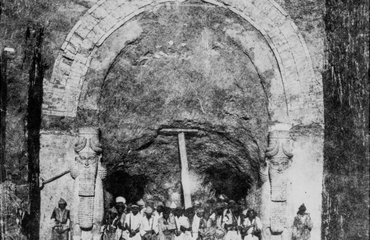


Dur Sharrukin - "Sargon's fortress" - was built by order of Sargon II of Assyria (721-705 BC). It was meant as a monument to his reign, but was abandoned after his death. Its discovery in 1843 revealed the magnitude of his endeavours.
During the Assyrian empire, the palace where the monarch resided, lay at the heart of power, a marriage of pomp and monumentality.
The objects and monuments of Khorsabad form a cornerstone of the collection of the Department of Near Eastern Antiquities at the Louvre Museum.

The four sides of the mound. Drawing by Eugène Flandin, published by Paul-Émile Botta in Monument de Ninive (which despite its title is about Khorsabad). 1843-1844
Musée du Louvre

Drawing by Eugène Flandin, published by Paul-Émile Botta in Monument de Ninive (which despite its title is about Khorsabad). 1843-1844
Musée du Louvre

Khorsabad. Group of workers in front of the fully exposed facade. City door no. 3 in Khorsabad. 1852. Gabriel Tranchand
Fonds Maurice Pillet. Académie des Inscriptions et Belles Lettres